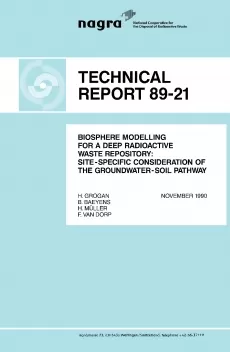
Technical Report NTB 89-21
Biospere modelling for a deep radioactve waste repositorySite-specific consideration of the groundwater-soil pathway
Scenario evaluations indicate that groundwater is the most probable pathway for released radionuclides to reach the biosphere from a deep underground nuclear waste repository. This report considers a small valley in northern Switzerland where the transport of groundwater to surface soil might be possible. The hydrological situation has been examined to allow a system of compartments and fluxes for modelling this pathway with respect to the release of radionuclides from an underground repository to be produced.
Assuming present day conditions the best estimate surface soil concentrations are calculated by dividing the soil into two layers (deep soil, surface soil) and assuming an annual upward flux of 10 mm from the groundwater through the two soil layers. A constant unit activity concentration is assumed for the radionuclides in the groundwater. It is concluded that the resultant best estimate values must still be considered to be biased on the conservative side, in view of the fact that the more typical situation is likely to be that no groundwater reaches the surface soil. Upper and lower estimates for the surface soil radionuclide concentrations are based on the parameter perturbation results which were carried out for three key parameters, i.e. precipitation surplus, upward flux and solid-liquid distribution coefficients (Kd). It is noted that attention must be given to the functional relationships which exist between various model parameters. Upper estimates for the surface soil concentration are determined assuming a higher annual upward flux (100 mm) as well as a more conservative Kd value compared with the base case. This gives rise to surface soil concentrations more than two orders of magnitude higher than the best estimate values. The lower estimates are more easily assigned assuming that no activity reaches the surface soil via this pathway.
Two appendices are included in this report. The first contains the calculations presented in the BIOMOVS study for the Mol region in Belgium, as defined in Scenario B6b. The second appendix presents an assessment of the potential significance of upward water movement in soil, due to capillary rise from groundwater in Switzerland, based on soil use maps.
